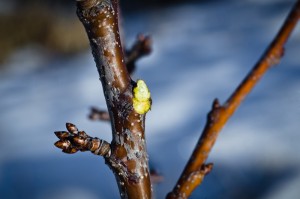Winter Pruning
Trees and shrubs need proper pruning for the health of the plant and to sustain or improve its good looks. Plants need regular pruning to remove dead or damaged branches, to shape or control the size of the plant, or to recover the natural style of the plant.
But why in winter?
Winter is actually a good time of year to prune your deciduous plants. It is the best time to take a critical look at your trees and shrubs. It is much easier to prune a plant without its leaves since you can easily see its branching structure. Also, with winter pruning there is less chance of transmitting diseases from one plant to another or attracting insects to fresh pruning wounds. According to the supervisor of plant health care at the Chicago Botanic Garden, 90 percent of deciduous pruning can be done in the winter. “As soon as trees and shrubs go into dormancy, pruning can begin, and you can prune up to the time when buds begin to plump up.” And, since most gardening chores in the Midwest get compressed into the short, intense growing season between Memorial Day and Labor Day it is useful to schedule some of them to winter.
 Good pruning practices at any time of year remove only what is absolutely necessary. For that reason is important to have a clear goal in mind. The idea is to highlight the plant’s natural features. If done well, it will look like nothing was done!
Good pruning practices at any time of year remove only what is absolutely necessary. For that reason is important to have a clear goal in mind. The idea is to highlight the plant’s natural features. If done well, it will look like nothing was done!
A Winter Pruning Visit will include:
Removal of undesirable branches. We remove all dead or diseased wood. We remove all suckers and water sprouts which will not develop into natural-looking, well-branched limbs. We remove crossing or rubbing branches unless doing so would disfigure the tree if removed.
Thin the canopy. Starting at the center and moving to the exterior, we thin the branches that make up the dense mass of a tree or shrub. This increases air circulation through the branches and accentuates the structure of the plant. Thinning is especially important for trees such as crabapples and hawthorns, which are susceptible to fungal diseases.
We step back and look. Is the tree balanced? Does it look symmetrical?
We follow proven horticultural practices for the health of each plant.
We look for insect problems. Egg masses of tent caterpillars, gypsy moths, and tussock moths are often visible on tree branches in winter. They are removed to control insect damage in the spring.
Look for signs of disease. We closely inspect branches, to check for unusual swellings, open lesions, or darkened areas that could be symptoms of canker and disease.
In our effort to constantly elevate and improve our services, we have added a 4th Maintenance Visit for selected clients to perform Winter Pruning. From mid-November to mid-March, we shape and thin your deciduous plants in preparation for the spring season ahead. Our Maintenance Specialist or your Designer will be in contact soon to discuss the program with you. But you can always contact us with your questions or to discuss future possibilities.

Glen Goldberg, Founder and President



